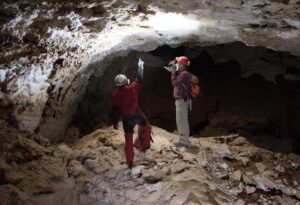
Griffith University—A new study published in Nature reveals the modern arid desert between Africa and Saudi Arabia was once regularly lush and green with rivers and lakes over a period of 8 million years, allowing for the occupation and movements of both animals and hominins.
The findings, led by an international team of researchers supported by the Saudi Heritage Commission, Ministry of Culture, shed new light on this hitherto unrecognized but important crossroad for biogeographic exchange between Africa and Eurasia.
The Saharo-Arabian Desert is one of the largest biogeographic barriers on Earth, limiting the dispersal of early humans and animals between Africa and Eurasia.
Recent research suggested the desert had been in place since at least 11 million years ago.
But Professor Michael Petraglia, Director of Griffith University’s Australian Research Centre for Human Evolution and co-author on the new study, said fossil evidence from the Late Miocene (marked by an increase in global temperatures) and Pleistocene (which contained multiple ice ages) suggested the episodic presence within the Saharo-Arabian Desert interior of water-dependent animals.
Animals such as crocodiles, equids, hippopotamids, proboscideans, were likely sustained by rivers and lakes that were largely absent from today’s arid landscape.
“These wetter conditions likely facilitated these mammalian dispersals between Africa and Eurasia, with Arabia acting as a key crossroads for continental-scale biogeographic exchanges,” Professor Petraglia said.
Dr Monika Markowska of Northumbria University, UK, and Dr Hubert Vonhof of the Max Planck Institute for Chemistry, Germany, conducted new work on cave speleothems (mineral deposits such as stalagtites and stalagmites) that led to the realisation that there were numerous humid phases in Arabia during the last 8 million years.
Dr Markowska, who was lead author on the study, explained that little was known about Arabia’s palaeoclimate before this time, noting: “The findings highlighted that precipitation during humid intervals decreased and became more variable over time, as the monsoon’s influence weakened, coinciding with enhanced Northern Hemisphere polar ice cover during the Pleistocene.”
Dr Faisal al-Jibrin, lead Saudi archaeologist of the Heritage Commission, said “Arabia has traditionally been overlooked in Africa-Eurasia dispersals, but studies like ours increasingly reveal it central place in mammalian and hominin migrations.”
The study ‘Recurrent humid phases in Arabia over the past 8 million years’ has been published in Nature.
____________________________

Based on a climatic record from desert speleothems, researchers show recurrent humid intervals in the central Arabian interior over the past 8 million years. Paul Breeze
____________________________
Article Source: Griffith University news release.
*Recurrent humid phases in Arabia over the past 8 million years, Nature, 10.1038/s41586-025-08859-6
____________________________
Advertisement

EXPLORE THE ANCIENT ETRUSCANS IN PERSON!
Experience a unique, up-close-and-personal hike among ancient hilltop towns in central Italy. You will walk the sensational countryside of the regions of Umbria and Tuscany, soaking in important sites attesting to the advanced Etruscan civilization, forerunners of the ancient Romans; imposing architectural and cultural remains of Medieval Italy; local food and drink; and perhaps best of all — spectacular scenic views! Join us in this collaborative event for the trip of a lifetime!


